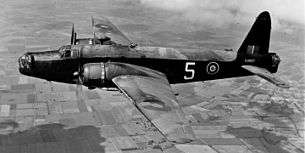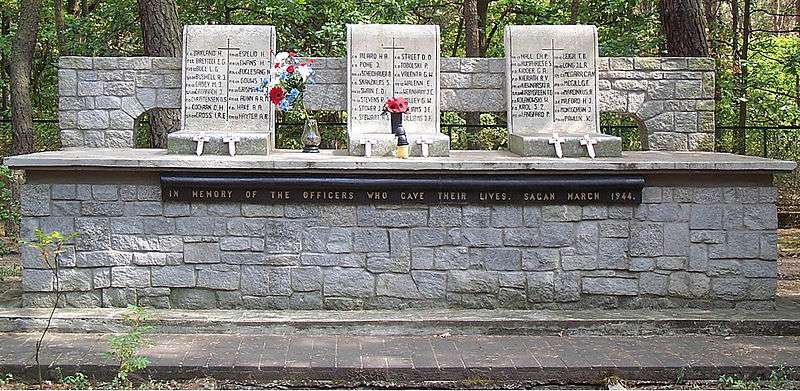Tim Walenn
| Gilbert William ("Tim") Walenn | |
|---|---|
 | |
| Birth name | Gilbert William Walenn |
| Nickname(s) | Tim |
| Born |
24 February 1916 Hendon, London |
| Died |
29 March 1944 (aged 28) Pruśce near Danzig |
| Buried at | Poznan Old Garrison Cemetery, Poland |
| Allegiance |
|
| Service/branch |
|
| Years of service | 1939–44 |
| Rank | Flight lieutenant |
| Unit | 25 (Bomber) Operational Training Unit |
| Battles/wars |
World War II |
| Awards |
Mentioned in despatches |
Gilbert William Walenn (24 February 1916 – 29 March 1944), known as Tim Walenn, was a British bomber pilot who was taken prisoner during the Second World War. He took part in the 'Great Escape' from Stalag Luft III in March 1944, but was one of the men re-captured and subsequently shot by the Gestapo.
Prewar service
Walenn was born in Hendon, north west London. He inherited a love of flight from his father who had served with the Royal Flying Corps in the 1914-18 War and drew aircraft as a child. After school he joined his uncle's design studio which produced designs for wallpaper and fabric.[1] Walenn became a bank clerk with the Midland Bank[2] in the hope of earning enough to pay for flying lessons and was founder member of the Midland Bank Flying Club. Walenn had connections to the East Finchley and Golders Green areas[3] when he enlisted in the Royal Air Force Volunteer Reserve in 1937 as a trainee pilot.[4] Walenn was commissioned as pilot officer on 1 September 1939,[5][6] and joined No. 97 Squadron RAF[7] as a bomber pilot.
Wartime service
Walenn was confirmed as pilot officer on 29 June 1940 and quickly being promoted to flying officer on 10 September 1940.[8] He was a flying instructor at No.10 Elementary Flying Training School for a year until August 1941 when he joined No. 25 Operational Training Unit[9] where he would be involved in "ops" (operational missions). He was promoted to flight lieutenant on 10 September 1941.[10]
Prisoner of war

Serving with B Flight of No.25 Operational Training Unit, Walenn took off in a Wellington Mark Ic bomber (serial number N2805) from RAF Finningley at 1955 hours on the night of 10 September 1941[11] to bomb the Misson ranges. At 0531 hours on the morning of 11 September the bomber was hit by anti aircraft fire and had to be abandoned. It crashed in Rotterdam’s Ijsselhaven. The entire crew of 5 baled out safely. Walenn was captured becoming a prisoner of war and was sent to Stalag Luft III in the province of Lower Silesia near the town of Sagan (now Żagań in Poland). Walenn was a well known character in the prison camp system for his skilful drawing but also for his enormous handlebar moustache[12][13] which had to be shaved off for the escape due to its unmistakable RAF style.[14]
'Great Escape'
For the Great Escape operation he utilized his artistic ability as head of forgery,[15] his team produced forged passports, movement orders, railway documentation and all manner of identity papers to move about Germany.[16] Walenn was one of the 76 men who escaped the prison camp on the night of 24–25 March 1944, in the escape now famous as "the Great Escape".

Travelling in a group of four escapees with Gordon Brettell, Romualdas Marcinkus and Henri Picard, all posing as French and Lithuanian workers they managed to reach a train heading towards Danzig (now Gdansk, Poland). Most likely, they intended to travel to East Prussia and cross the Lithuanian border hoping to cross the Baltic Sea to neutral Sweden. When the Germans discovered the escape they began manhunts. Walenn and his group travelled further than most of the escapees, but were captured by the Gestapo near Schneidemühl on 26 March. The party of four were brought to Stalag XX-B and spent the night there, their presence being carefully recorded by the camp sergeant-major who issued them with clothing more suited to a prisoner of war in the hope of avoiding the possibility of them being charged with espionage. On the following day they were handed over to the Danzig Gestapo.[17] Its officials took the men to a forest near Prusce and executed them.[18][19] On 29 March his body was cremated in Danzig's Gestapo crematorium.
He was only one of the 50 escapers executed and murdered by the Gestapo.[20] Originally cremated and buried at Sagan, he is now buried in part of the Poznan Old Garrison Cemetery.[21] Walenn's headstone has the inscription chosen by his parents: "In proud memory of our gallant and beloved son".[22]
Walenn's name was amongst those in the list of the murdered prisoners which was published when news broke on or about 20 May 1944.[23]

Awards
His conspicuous bravery was recognized by a mention in despatches as none of the other relevant decorations then available could be awarded posthumously. It was published in a supplement to the London Gazette on 8 June 1944.[24]
Other victims
The Gestapo executed a group of 50 of the recaptured prisoners representing almost all of the nationalities involved in the escape.
Post-war investigations saw a number of those guilty of the murders tracked down, arrested and tried for their crimes.
| Nationalities of the 50 executed |
References
- Notes
- ↑ Vance (2000), p.43
- ↑ Dundee Evening Telegraph, 19 May 1944, front page
- ↑ London Electoral Register 1939, East Finchley ward, p.46
- ↑ Vance, Jonathan F (2000). A Gallant Company: The Men of the Great Escape. Pacifica Military History. p. 44. ISBN 978-0-935-55347-5.
- ↑ RAF List (January 1941), p.1574
- ↑ RAF List, August 1939
- ↑ Vance (2000), p.44
- ↑ The London Gazette: no. 35019. pp. 7129–7130. 20 December 1940. Retrieved 15 August 2015.
- ↑ Vance (2000), p.44
- ↑ The London Gazette: no. 35373. pp. 6995–6996. 9 December 1941.
- ↑ Chorley (1993), p.71
- ↑ Andrews (1976) pp.36–37
- ↑ Read (2012), p.8
- ↑ Burgess (1990) p.130
- ↑ Read (2012), p.8
- ↑ Andrews (1976) p.36
- ↑ Burgess (1971) p.255
- ↑ Read (2012), p.210-220
- ↑ Andrews (1976), p.93
- ↑ Andrews (1976), p.209
- ↑ Commonwealth War Graves Commission casualty - Gilbert William Walenn
- ↑ Commonwealth War Graves Commission, Headstone Schedule form H/2, Poznan Old Garrison Cemetery
- ↑ Western Morning News, Dundee Courier, Yorkshire Post, etc. 20/05/1944
- ↑ The London Gazette: (Supplement) no. 36544. pp. 2621–2622. 2 June 1944.
- Bibliography
- Jonathan F Vance (2000). A Gallant Company. I books. ISBN 0-7434-7525-9.
- William Ash; Brendan Foley (2005). Under the Wire: The Wartime Memoir of a Spitfire Pilot, Legendary Escape Artist and 'cooler King'. Bantam. ISBN 978-0-593-05408-6.
- Paul Brickhill (2004). The Great Escape. W.W. Norton & Company. ISBN 978-0-393-32579-9.
- Alan Burgess (1990). The Longest Tunnel: The True Story of World War II's Great Escape. Naval Institute Press. ISBN 978-1-59114-097-9.
- Albert P. Clark (2005). 33 Months as a POW in Stalag Luft III: A World War II Airman Tells His Story. Fulcrum Pub. ISBN 978-1-55591-536-0.
- Arthur A. Durand (1 January 1989). Stalag Luft III: The Secret Story. Patrick Stephens Limited. ISBN 978-1-85260-248-2.
- William R Chorley (1993). RAF Bomber Command Losses, Volume 7. Midland Counties. ISBN 1-85780-132-6.
- Allen Andrews (1976). Exemplary Justice. Harrap. ISBN 0-245-52775-3.
- Simon Read (2012). Human Game. Constable. ISBN 978-1-4721-1262-0.
External links
- Project Lessons from the Great Escape (Stalag Luft III), by Mark Kozak-Holland. The prisoners formally structured their work as a project. This book analyses their efforts using modern project management methods.